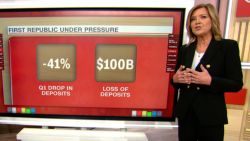Editor’s Note: A version of this story appeared in CNN Business’ Nightcap newsletter. To get it in your inbox, sign up for free, here.
A summary of where things stand in the banking crisis:
The Fed: “Banks are fine.”
The Treasury: “Banks are fine.”
The banks: “We’re fine.”
Wall Street: “Everybody sell, the banks are on fire!”
Here’s the deal: When Silicon Valley Bank crumbled on March 10, it was a Main Street problem — scared depositors rushed to pull out their money, and the bank ran out of cash. A classic bank run.
Seven weeks later, despite the government’s intervention to backstop depositors and extend credit to banks, the panic has taken root on Wall Street, which is now feeding on its own anxiety.
“We’re seeing a lot of concern here that something’s about to break,” Ed Moya, a senior market analyst with Oanda, told me. “This contagion fear has not eased up whatsoever.”
How a Main Street bank run infects Wall Street
After First Republic on Monday became the third US lender to fail this year, investors shifted their angst toward PacWest Bancorp, yet another regional California lender, whose share price was cut in half Thursday after it confirmed it was “exploring strategic options” (read: seeking a buyer, stat).
Western Alliance was also flagging Thursday after the Financial Times reported that the bank was exploring a sale. The Arizona lender denied the report, helping its stock pare some losses. It was still down 33% midday in New York, and has lost more than 65% of its value this year.
Similarly, southeastern regional bank First Horizon was teetering, having scrapped a $13 billion merger with Canada’s TD bank.
While this latest crop of regional banks bears some similarities to the three that failed this year, they don’t appear to have the same reliance on uninsured deposits that got the others in trouble.
PacWest reported Thursday that withdrawals had slowed and that 75% of its deposits were insured and the bank remained flush with cash.
“The bank has not experienced out-of-the-ordinary deposit flows following the sale of First Republic Bank and other news,” it said. “Our cash and available liquidity remains solid and exceeded our uninsured deposits, representing 188%.”
In normal times, those numbers might have alleviated investors’ fears, Moya said. But these aren’t normal times.
“Even if the the numbers don’t look that bad, once the market has its eyes on you, it’s game over,” he said.
That market pessimism was echoed by Bill Ackman, the billionaire investor, who tweeted Thursday that regional banks broadly are in trouble.
“Confidence in a financial institution is built over decades and destroyed in days,” he wrote. “As each domino falls, the next weakest bank begins to wobble.”
What’s the fix?
Ackman and others have been arguing for the government to step in and lift the limit on deposit insurance, which currently tops out at $250,000 — a fraction of what some businesses must hold in their balances to run their day-to-day operations.
But such a change would require bipartisan support in Congress. And no rational market players are holding their breath for that.
Banks are also contending with a potential recession and more interest rate hikes from the Fed. But one giant psychological barrier could be overcome if America alleviates its debt ceiling crisis.
Earlier this week, Treasury Secretary Janet Yellen warned that the government would hit the debt ceiling on or around June 1 unless Congress raises its borrowing authority. It’s hard to overstate how catastrophic the result of default would be — think 2008 global financial meltdown, or quite possibly worse.
The debt ceiling is the biggest question right now for markets.
“Is it a 90% probability that we’re not going to default? Yes. But given the players that are involved, I’m still concerned,” Moya said.
How does this all end?
Without a miracle from DC, the outlook for regional banks is not great.
There is so much pessimism percolating on Wall Street, smaller banks are going to get crushed. PacWest isn’t hurting because it made bad bets or mismanaged its company — it’s just the next one on the list, analysts say.
Gutting regional banks would have massive implications for the US economy, as those smaller operations tend to offer businesses sector-specific expertise that they can’t get from Wall Street power players like JPMorgan Chase or Bank of America.
Consolidation is particularly risky at this moment in America, when the Biden administration is trying to bolster manufacturing and domestic supply chains.
“We’re trying to revive the productive sectors of the economy, as distinguished from the financialized sectors of the economy,” said Robert Hockett, a law professor and expert on public finance at Cornell University. “And at the core of all of that is regional banking sector … Wall Street banks are much more focused on the global economy, much more focused speculation of various kinds.”
That sector specificity, Hockett notes, creates the dilemma we’re seeing now: Almost by definition, those specialized lenders are not as diversified in their holdings. Many have loaded up on Treasuries, which, ironically “are the most boring of all possible investments.”
Another problem: Who wants to buy a struggling bank, even at a discount, if you can get it for pennies on the dollar after it fails — complete with a guarantee against losses, backed by Uncle Sam?
That means we can expect more bank failures, and more Wall Street panic, in the weeks and months ahead.
Enjoying Nightcap? Sign up and you’ll get all of this, plus some other funny stuff we liked on the internet, in your inbox every night. (OK, most nights — we believe in a four-day work week around here.)



























